So what is the best way to water your lawn?

Considerations for watering your lawn
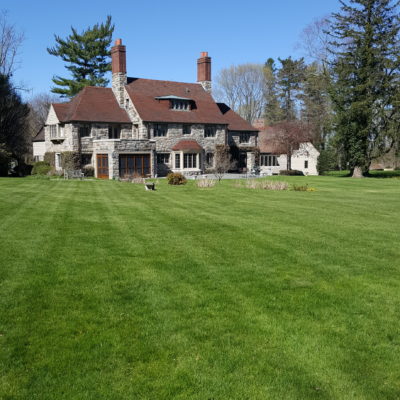 There are general guidelines to watering, and they will vary depending on a variety of factors for your lawn. What are those factors? For starters, is your lawn sunny or shady?
There are general guidelines to watering, and they will vary depending on a variety of factors for your lawn. What are those factors? For starters, is your lawn sunny or shady?
What type of soil do you have? Or do you have any ledge or large rocks under you turf near the surface?
Another factor to consider is your property location and how the weather interacts with your property.
And, another thing to remember is that your lawn is competing for water with the trees and bushes on your property.
As you can see, there can be many factors that will impact how you water your lawn and those factors can greatly effect how you water throughout the seasons.
Remember that watering is 1/3 of your overall equation to a great and healthy lawn, so it’s important to get this right. Too much water is detrimental to your lawn’s health as this creates the an environment for growth of turf diseases, root rot, and insect problems.
How often should I water my lawn?
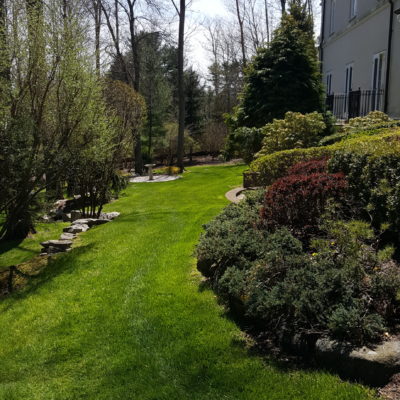 When watering your lawn, you should be striving for 1 inch of water a week for just your lawn. You should be also compensating for your bushes and trees which should be getting about the same. That being said, I would recommend checking with your arborist on best watering practices for trees.
When watering your lawn, you should be striving for 1 inch of water a week for just your lawn. You should be also compensating for your bushes and trees which should be getting about the same. That being said, I would recommend checking with your arborist on best watering practices for trees.
Remember that all living plants are competing for the water on your property. You need to consider your soil type to see how much water retention is retained in the soil. This will depend on what type of soil is on your property and this can adversely effect your watering. A soil test is always a good idea so you know what type of soil you have and what the PH is.
You always strive for balance with nature, and water conservation is recommended as a best practice. This will help conserve water, and it reduces pests and fungus. That is both good for your wallet and good for the environment.
Spring season guidelines for watering your lawn in Fairfield County CT:
As a general guideline for the spring season, mother nature generally does a good job of watering your lawn. And by being conscious with what the weather is doing, you most likely will not need to water much (if at all) in the spring. So any irrigation systems or watering with another type of system just serves as a supplement if mother nature has a shortfall if there is a sustained period with little to no rain.
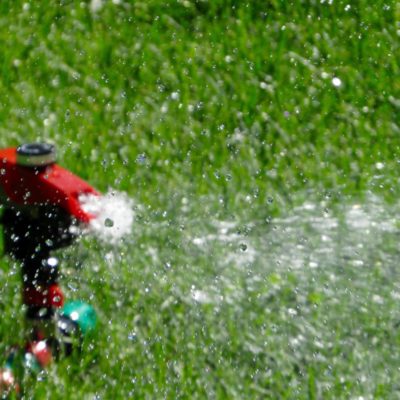 Generally, most of your watering will be needed during the summer months when there is little to no rain and hotter days causing more evaporation.
Generally, most of your watering will be needed during the summer months when there is little to no rain and hotter days causing more evaporation.
Summer Season Guidelines for watering your lawn
During the summer months, the weather can get a bit extreme here in the Lower Fairfield County and the Northeast. We can have very high temperatures and high humidity on some days and very low humidity on other days. Lawns can get stressed due to these fluctuations, and the lack of water coupled with high temperatures in the summer months can be very draining for your lawn.
That being said, it is okay to let your lawn go dormant during the summer months, and it will generally bounce back in the fall when the temperatures cool and the rain returns. Depending on the length of dormancy and if there are any other unforeseen damages that occur during this time frame, the lawn may not recover 100%. So in the summer months I recommend increasing your water output up to an additional 1/2 inch per week (for a total of 1.5 inches/week).
The additional watering should be done as a syringe shot to the lawn where it is the sunniest during the middle of the day. You should water when it is the hottest – usually between 1pm and 2pm for 10 minutes to cool the lawn down. This is especially important during a heat waves or temperatures that are reaching 100+ degrees.
Fall Guidelines for watering your lawn:
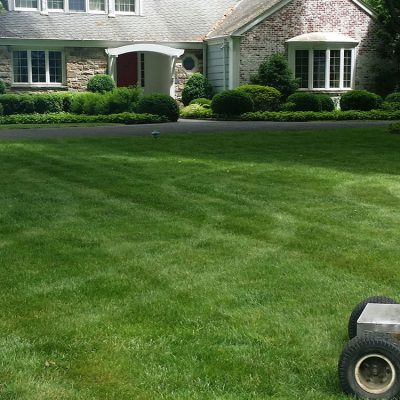 During the fall months or after Labor day, Mother Nature seems to come back in our favor with cool evenings and normal rain starts to return. So you can go back to a Spring type of watering schedule where mother nature does the watering for us.
During the fall months or after Labor day, Mother Nature seems to come back in our favor with cool evenings and normal rain starts to return. So you can go back to a Spring type of watering schedule where mother nature does the watering for us.
Even if it doesn’t rain, we tend get condensation in the very early morning hours in the form of morning dew which the lawn also utilizes. Basically, in a normal year in the Spring and Fall you will be watering sparingly unless the weather dictates otherwise. Sparingly means 1 time a week to every other week. Remember April showers bring May flowers, so keep an eye on those showers and reduce the amount of water you add to your lawn.
So how often should you water shady lawns vs sunny lawns?
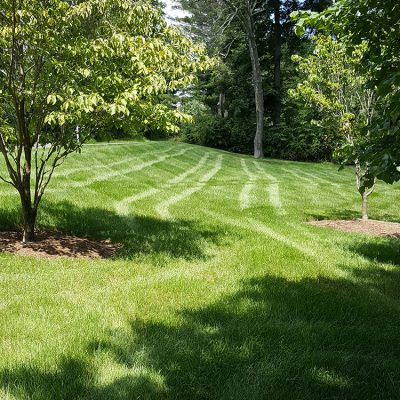 This answer is broken down to Sunny lawns and Shady lawns. To keep it simple, there are many other factors that play into watering such as site area being watered. In shady areas in the lawn, your watering schedule should look like 3 to 4 a week for 15 minutes. It maybe a little longer if you are watering 3 times a week, remember you are trying to get 1 inch of water on your lawn.
This answer is broken down to Sunny lawns and Shady lawns. To keep it simple, there are many other factors that play into watering such as site area being watered. In shady areas in the lawn, your watering schedule should look like 3 to 4 a week for 15 minutes. It maybe a little longer if you are watering 3 times a week, remember you are trying to get 1 inch of water on your lawn.
In the shady parts of your lawn you tend to have shallow root grasses like Poa Annua that tend to thrive in the shady parts of your lawn. This is an annual blue grass that is indigenous to our area and is an annual weed which can be very difficult to control. Most people don’t notice the difference until the summer months when this plant dies back due to it’s shallow roots and high heat.
In sunny parts of the lawn, you are trying to get the same amount of water down. However, the methodology changes from 3 to 4 times a week to 1 to 2 times a week. What we are after is deep saturating waterings, so that you saturate the soil and allow the water to penetrate deeper. This encourages the roots to extend their energy and create deeper roots to capture the water in the lower areas of the soil.
A deeper root system creates a healthier turf by enabling the grass to be more drought resistant. It also allows the grass to become a more efficient water and nutrient user since it to now stores more in its root system. So you should water 45 to 60 minutes in the summer months (depending on the weather) when you are looking to achieve 1.5 inches a week.
When is the best time to water your lawn? Is it better to water your lawn in the morning or evening?
 The best time to water your lawn is always in the morning, and I can not stress this enough! You should be watering your lawn between 5am and 10am.
The best time to water your lawn is always in the morning, and I can not stress this enough! You should be watering your lawn between 5am and 10am.
The reason for this is you want the water to penetrate into the soil while keeping evaporation to a minimum. The other main reason for watering in the morning is to keep the grass blades dry. What I mean by this is that when you water your lawn everything gets wet and we want the blades of grass to be dried as quickly as possible. The main reason for this is water is way for fungus and other diseases to transport their spores to other parts of the lawn.
This is also why you should never water your lawn in the evening. Watering in the evening can create optimal conditions fungus to grow and ruin your lawn. Also, in the evening, it’s more challenging to see and hard to gauge what is going on. Nothing is more frustrating tham driving home at night while its raining and seeing an irrigation system running.
 When watering newly seeded grass you want to follow a daily 5 to 10 minute watering on grass seed that has not germinated yet. We are trying to get the soil damp, kind of similar to a clay tennis court for those that follow tennis. The reason for this is to encourage germination. Once germination has occurred, you will want to change your watering every 3rd day for 10 minutes. We are striving for light frequent watering on the new lawn until your first cut; then go back to your regular watering schedule for that part of the lawn.
When watering newly seeded grass you want to follow a daily 5 to 10 minute watering on grass seed that has not germinated yet. We are trying to get the soil damp, kind of similar to a clay tennis court for those that follow tennis. The reason for this is to encourage germination. Once germination has occurred, you will want to change your watering every 3rd day for 10 minutes. We are striving for light frequent watering on the new lawn until your first cut; then go back to your regular watering schedule for that part of the lawn.
In conclusion, there are many factors that go into watering your lawn and the above article is a guideline for on how you should water. You should always check with a knowledgeable professional who can best help you with how to water for your specific property. Landscape Architects, Arborists, Lawn care professionals, landscapers and irrigation companies are all great resources, but when they work together their results are synergistic and can make your property stand out.
Related articles:
When you’re ready for a beautiful and healthy lawn, call us at Lawn Solutions 203-.424-1164. Our estimates are always FREE. Or, fill out our contact form below.
Map of Lower Fairfield County CT – Lawn Solutions
Watering your lawn – Best Watering practices for your Lawn in Fairfield County CT


Mason Smith says
It’s a great point that all the plants on your property are fighting for that water. My brother is trying to get a great looking lawn this fall so that he is prepared for next spring. He needs to work with some local professionals that can help him get the lush lawn he wants.